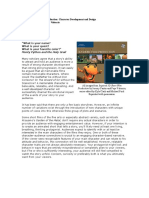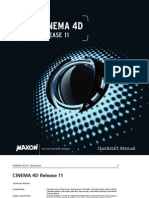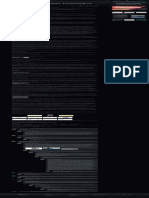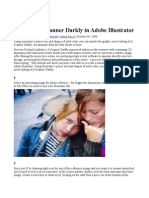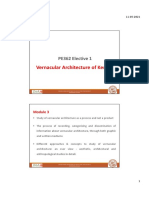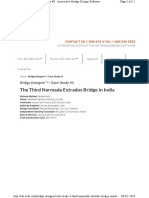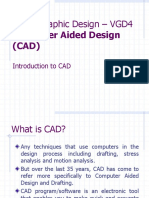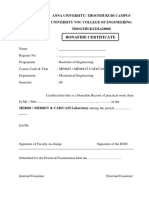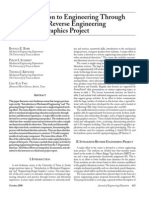Modeling and Texturing
Uploaded by
Stephenson11ChurchModeling and Texturing
Uploaded by
Stephenson11ChurchModeling and Texturing
Desires to know about kind of animation in order to planning, the first thing you must do is
create the objects you want to use in your animation. In keeping the actual use of live action
metaphor, objects can be thought of anything that is when in front of the camera, this
includes actors, props, and panoramas. Modeling is the process through which you can build
all of the objects that does happen in your scene.
The easiest way top get started modeling is primitives which are simple 3D shapes that
include most software packages. These cubes, spheres, cylinders, cones, pyramids and
planes can be combined to create more complex objects. This process rrs extremely much
like building with blocks of legos. Do not need to actually build the pieces you use you just
put them together. Must be built an object by combining some primitives chances are you
would want to link these together, rrn order that whenever you move one piece the rest will
move together. A second way to create one is by starting into two dimensions. Almost every
3D package gives you opporutnity to draw a curve or perhaps a shape, manipulated and that
as a basis for creating a model. The types of curves you can create vary from program to
program and each the years have its own set up characteristics. In addition most software's
will allow that import 2D curves from some other programs such as adobe illustrator. After
making a curve there are quite a few of ways to bring it into the third overall size. The
simplest being revolving an extruding.
Once you have finished modeling you are prepared to create the next help the 3D process. If
objects are your actor s then textures are their costumes. While model ing defines the shape
of your objects textures define what their surfaces look like there are 2 basic types of
textures, materials and image maps. You'll find that most projects both types of textures.
Most programs come with a offered of materials that you can simply select from a menu and
apply to your objects there is a wide variety of metal, stone, wood, skin, glass and liquid to
choose from. For instance the real world, materials differ from one another in a way they will
reflect light. The methods in which objects appear to the eye, say glass vs. metal, is the
outcome of the combination of all of the properties; these include colour , diffused shading,
ambience shading, reflectivity and openness. All of the pre made materials linked to software
packages have these properties already defined. Glass is defined as transparent, partially
reflective and just a little diffused. Stainless steel is done opaque, very reflective and barely
diffused. These properties can be combined within an infinite no. of solutions to produce any
desired direct result.
Image maps are 2D images that are "placed" on the surface of the object. Image, maps can
also be tile4d to cover a complete object. Some software packages also allow you to make
use of moving images as textures allowing you to guide.
You might also like
- Inspired 3D Short Film Production - Character Development and DesignNo ratings yetInspired 3D Short Film Production - Character Development and Design41 pages
- Aotc Autodesk 3ds Max 9 Maxscript Essential - UnlockedNo ratings yetAotc Autodesk 3ds Max 9 Maxscript Essential - Unlocked5 pages
- Low Poly 3D Modeling in Blender: Kickstart your career as a 3D artist by learning how to create low poly assets and scenes from scratchFrom EverandLow Poly 3D Modeling in Blender: Kickstart your career as a 3D artist by learning how to create low poly assets and scenes from scratchNo ratings yet
- Manual Maxon Cinema 4D Bodypaint 3D PDFNo ratings yetManual Maxon Cinema 4D Bodypaint 3D PDF496 pages
- Perancangan Animasi 3D "Cuma Mimpi" Menggunakan Pemodelan High Poly Pada Zbrush 3.5R3 Dan 3Ds Max 2009No ratings yetPerancangan Animasi 3D "Cuma Mimpi" Menggunakan Pemodelan High Poly Pada Zbrush 3.5R3 Dan 3Ds Max 20099 pages
- Create A Facial Animation Setup in Blender Part 2No ratings yetCreate A Facial Animation Setup in Blender Part 261 pages
- Name of The Lab (Multimedia Technologies)No ratings yetName of The Lab (Multimedia Technologies)11 pages
- Real-Time Physics Based Simulation For 3D Computer GraphicsNo ratings yetReal-Time Physics Based Simulation For 3D Computer Graphics120 pages
- Unwrap A Character in 3DS Max - Sackboy TutorialNo ratings yetUnwrap A Character in 3DS Max - Sackboy Tutorial58 pages
- 03 Wouter Tutorials How To Use HDR Images in VrayNo ratings yet03 Wouter Tutorials How To Use HDR Images in Vray18 pages
- Texturing and Paint Effects With Maya Exam Rivision PapersNo ratings yetTexturing and Paint Effects With Maya Exam Rivision Papers16 pages
- 3D-Computer Animation: Dhole Patil College of Engineering, Pune Department of Computer EngineeringNo ratings yet3D-Computer Animation: Dhole Patil College of Engineering, Pune Department of Computer Engineering22 pages
- (TUTORIAL) Motion Tweening in OpenToonz by PowerOfSin On DeviantArtNo ratings yet(TUTORIAL) Motion Tweening in OpenToonz by PowerOfSin On DeviantArt1 page
- Imitating A Scanner Darkly in Adobe IllustratorNo ratings yetImitating A Scanner Darkly in Adobe Illustrator6 pages
- How to Draw Zombies: Including How to Draw Zombie Characters and How to Draw Cartoon Zombies - Vol 2From EverandHow to Draw Zombies: Including How to Draw Zombie Characters and How to Draw Cartoon Zombies - Vol 2No ratings yet
- MAXON Cinema 4D R20: A Detailed Guide to Modeling, Texturing, Lighting, Rendering, and AnimationFrom EverandMAXON Cinema 4D R20: A Detailed Guide to Modeling, Texturing, Lighting, Rendering, and AnimationNo ratings yet
- Mastering Unity: Advanced Techniques for Interactive Design: Unity Game Development SeriesFrom EverandMastering Unity: Advanced Techniques for Interactive Design: Unity Game Development SeriesNo ratings yet
- 1 What Is 3D Modeling?: 1.1 Model StructureNo ratings yet1 What Is 3D Modeling?: 1.1 Model Structure27 pages
- Piping Design Basics - Isometric Drawings - What Is PipingNo ratings yetPiping Design Basics - Isometric Drawings - What Is Piping13 pages
- The Third Narmada Extrados Bridge in India: Bridge Designer™: Case Study #3100% (1)The Third Narmada Extrados Bridge in India: Bridge Designer™: Case Study #312 pages
- Visual Graphic Design - VGD4: Computer Aided Design (CAD)No ratings yetVisual Graphic Design - VGD4: Computer Aided Design (CAD)14 pages
- Advanced Engineering Informatics: Full Length ArticleNo ratings yetAdvanced Engineering Informatics: Full Length Article15 pages
- 4-Visualization techniques for augmented reality-09-01-2025No ratings yet4-Visualization techniques for augmented reality-09-01-20259 pages
- Matlab Toolbox For Kinematic Analysis and SimulatiNo ratings yetMatlab Toolbox For Kinematic Analysis and Simulati10 pages
- Free AutoCAD Tutorials - Boolean - Union, Subtract, in AutoCAD 2010 2012 2013No ratings yetFree AutoCAD Tutorials - Boolean - Union, Subtract, in AutoCAD 2010 2012 20136 pages

